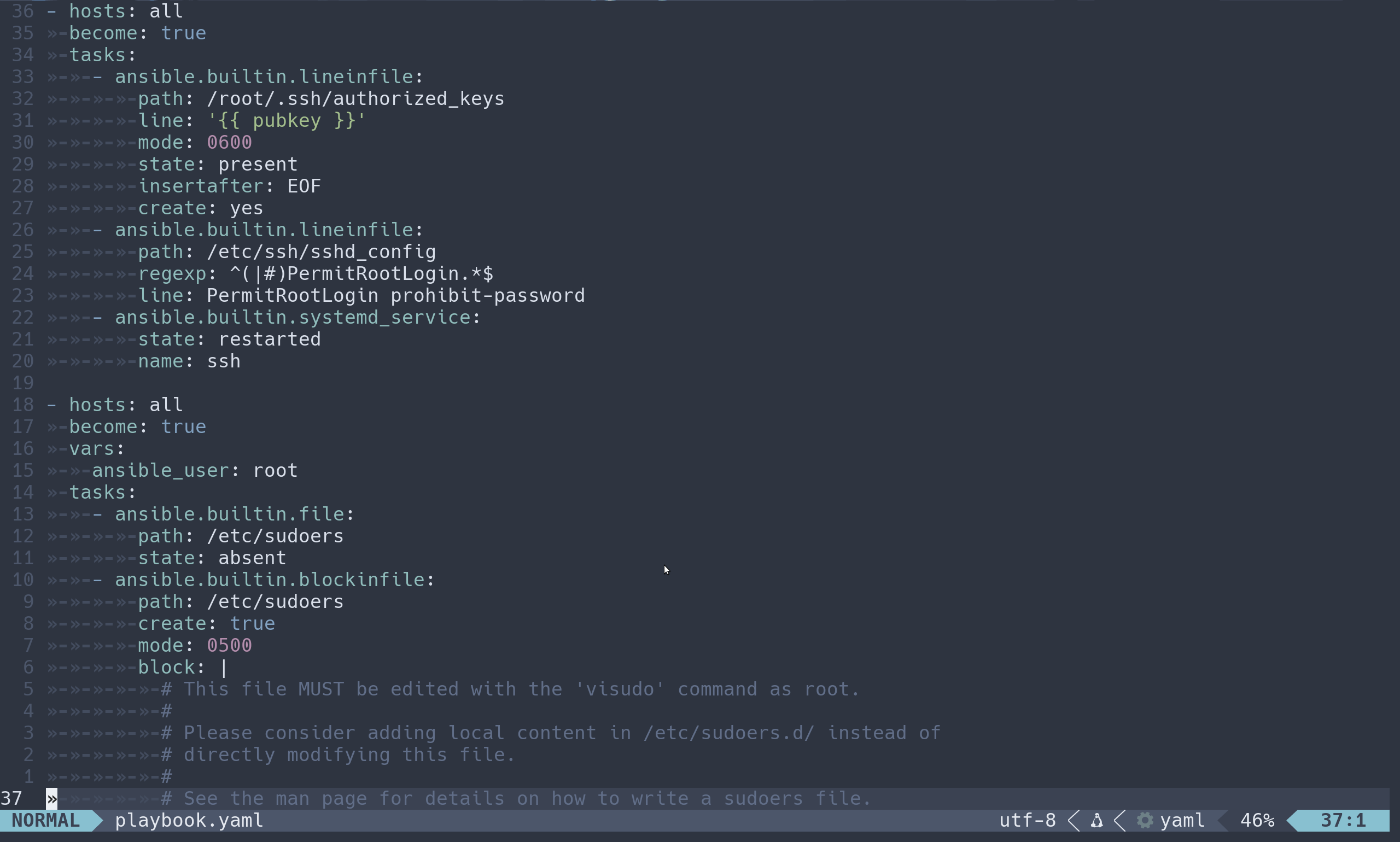
Table of Contents
Introduction
I always thinking is it possible to write only this command,
$ ansible-playbook playbook.yamlwithout adding another parameter like -K or -i or another parameter and it should be dynamicly without installing a single extra dependency.
After some hours wasting time for reading documentation, hallucinate with Gemini and ChatGPT, and some experimenting, you just need to write all your credentials and ansible spec in the playbook inventory.
Requirements
The method that I’ve used only using all tools that installed from ansible that you don’t need to installing another dependencies for achieve this.
From Ansible, we need only use this tool:
ansible-playbook-> For execute your ansibleansible-vault-> (Optional) for encrypt your credentials
You can download Ansible from this documentation. There’s a bunch of method that can be you used for installing Ansible since Ansible written in Python.
Folder Structure
ubuntu
├── vars
| └── user.yaml -> Shorthand for modify vars
├── ansible.cfg -> Ansible configuration
├── Inventory.yaml -> Inventory
└── playbook.yaml -> PlaybookStudy Case
In this article, I will discuss my case which is currently going to do massive modification on sudoers. My server right now using LDAP with a bunch of groups so it’s impossible to execute without running as root. The step that I need to execute is:
1. Using my user
- Grant my SSH Key to root user
- Modify SSH Config to permit root login
2. Using Root
- Reset sudoers and remove all unecessary rules
- Add new groups as an admin
3. Using my user again
- Delete my SSH Key in root user
- Modify SSH Config to not permit all login request to root
Code
This is the magic happened.
ansible.cfg
This file is only for pinning Inventory and Python Interpreter path. You can modified like this:
[defaults]
inventory = Inventory.yaml
ansible_python_interpreter = /usr/bin/python3Inventory.yaml
This file used to save all your configuration like user login, password, and another configuration that need to be consume to playbook.
If the inventory contains super-credentials value, this is the perfect time to using ansible-vault to encrypt the inventory file.
# We start from `all` hosts, but if you want to create host category, you can use all.children.<groupname> props.
all:
hosts:
# Set group name called server
server:
ansible0.local:
# Initial user of the server. You can safely remove this variable if all the initial user on each
# server is same.
initial_user:
# Username of the initial_user
# (str) => default: ubuntu
username: ubuntu
# Password of the default user
# (str) => default: None
password: ''
# Public key of the initial user
# (str) => default: None
pubkey: 'ssh-ed25519 uwu_uwu ikr4m@uwuntu'
vars:
# Initial user of the server. You can safely remove this variable.
# Use this variable if all initial_user is same on each node.
initial_user:
# Username of the initial user
# (str) => default: ubuntu
username: ubuntu
# Password of the initial user
# (str) => default: None
password: ''
# Public key of the initial user
# (str) => default: None
pubkey: 'ssh-ed25519 uwu_uwu ikr4m@uwuntu'vars/user.yaml
This file used to parse initial_user variable in Inventory. This is the reason that you didn’t need to add -K and prompting your password before executing ansible-playbook.
ansible_user: >-
{{
(hostvars[inventory_hostname].initial_user.username
if hostvars[inventory_hostname].initial_user is defined
else initial_user.username)
}}
ansible_become_pass: >-
{{
(hostvars[inventory_hostname].initial_user.password
if hostvars[inventory_hostname].initial_user is defined
else initial_user.password)
}}ansible_user and ansible_become_pass is a Special Variables that will be automatically consumed by Ansible before connecting to SSH.
playbook.yaml
Self-explanatory. This is your playground.
# Step 1: Setup Root
- hosts: all
become: true
tasks:
- name: Get initial_user variable
ansible.builtin.set_fact:
initial_user: '{{ hostvars[inventory_hostname].initial_user if hostvars[inventory_hostname] is defined else intial_user }}'
- name: Add new public key
ansible.builtin.lineinfile:
path: /root/.ssh/authorized_keys
line: '{{ initial_user.pubkey }}'
mode: 0600
state: present
insertafter: EOF
create: yes
- name: Set PermitRootLogin
ansible.builtin.lineinfile:
path: /etc/ssh/sshd_config
regexp: ^(|#)PermitRootLogin.*$
line: PermitRootLogin prohibit-password
- name: Restart SSH
ansible.builtin.systemd_service:
state: restarted
name: ssh
# Step 2: Modify Sudoers
- hosts: all
become: true
vars:
# Change user to root
ansible_user: root
tasks:
- name: Remove sudoers
ansible.builtin.file:
path: /etc/sudoers
state: absent
- name: Add sudoers with initial state
ansible.builtin.blockinfile:
path: /etc/sudoers
create: true
mode: 0500
block: |
# This file MUST be edited with the 'visudo' command as root.
#
# Please consider adding local content in /etc/sudoers.d/ instead of
# directly modifying this file.
#
# See the man page for details on how to write a sudoers file.
#
Defaults env_reset
Defaults mail_badpass
Defaults secure_path="/usr/local/sbin:/usr/local/bin:/usr/sbin:/usr/bin:/sbin:/bin:/snap/bin"
# This fixes CVE-2005-4890 and possibly breaks some versions of kdesu
# (#1011624, https://bugs.kde.org/show_bug.cgi?id=452532)
Defaults use_pty
# User privilege specification
root ALL=(ALL:ALL) ALL
# See sudoers(5) for more information on "@include" directives:
@includedir /etc/sudoers.d
- name: Add new file for admin user
ansible.builtin.file:
path: /etc/sudoers.d/01-admin-user
state: touch
mode: 0600
- name: Append file to admin user
ansible.builtin.blockinfile:
path: /etc/sudoers.d/01-admin-user
create: true
mode: 0600
block: |
# Grant atmint groups to execute sudo
%atmint ALL=(ALL) ALL
# Step 3: Reset Root
- hosts: all
become: true
tasks:
- name: Remove authorized key
ansible.builtin.file:
path: /root/.ssh/authorized_keys
state: absent
- name: Create new empty authorized key
ansible.builtin.file:
path: /root/.ssh/authorized_keys
state: touch
mode: 0600
- name: Set PermitRootLogin to none
ansible.builtin.lineinfile:
path: /etc/ssh/sshd_config
regexp: ^(|#)PermitRootLogin.*$
line: PermitRootLogin no
- name: Restart SSH
ansible.builtin.systemd_service:
state: restarted
name: sshApply Playboook
Now for the magic moment. To run the entire process, you can execute:
$ ansible-playbook playbook.yaml